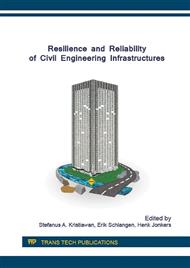p.113
p.119
p.126
p.132
p.140
p.148
p.154
p.158
p.166
Determination of Damage Location in Reinforced Concrete Beams Using Mode Shape Curvature Square (MSCS) Method
Abstract:
This paper presents a numerical algorithm technique to detect cracks propagated in concrete beams based on the frequency response curve of the beam determined from vibration testing. Impact tests on simply supported reinforced concrete beams were conducted to measure vibration on the beam. The ICATS software was carried out to capture the Frequency Response Functions (FRFs) data at each load step. Utilizing the FRFs data, a numerical algorithm based on finite different methods was performed to compute the different FRFs between undamage and damage beams based on the mode shape curvature square (MSCS) method. The numerical damage location was defined by subtracting the MSCS undamage to damage of beams. Therefore, the accurate damage location was identified by comparing the numerical and observed experimental results.
Info:
Periodical:
Pages:
140-147
Citation:
Online since:
July 2016
Authors:
Price:
Сopyright:
© 2016 Trans Tech Publications Ltd. All Rights Reserved
Share:
Citation:


